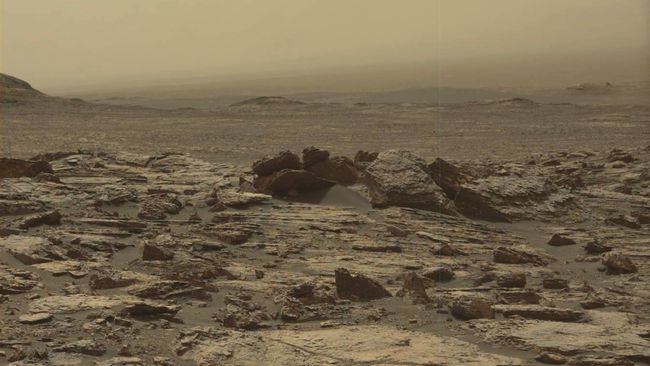In the distant past, it is possible that a body of water on Mars was teeming with microbial life.
During the examined period, researchers found that manganese oxide sediments were in the waterbed in the area where it is likely that the shoreline existed billions of years ago.
The Curiosity Mars rover has seen some interesting chemical stuff; in presence of unusual high amounts of manganese oxide which may be the clues of a connection between manganese oxide and microbes in Mars.
NASA’s Curiosity is the one that is currently exploring the huge 96-mile diameter Gale crater where the rover landed in 2012. Its discoveries indicate that scientists are not sure all the alien’s secrets, but it is likely that the crater was at least partially flooded long ago. And that is where the debate has begun. Nevertheless, the rover’s latest data not only reinforce the idea of the lake presence and its time-span, but they also tested environment of the lake and found that this environment was suitable for life.
The data is linked to the chemical compound manganese oxide. It has also seen the harsh reality that studying organic compounds by the advanced observation tools is possible in the beginning, but when the mission becomes longer, these tools are used due to the increased sedimentary bedrocks of a mudstone geological unit named the Murray Formation. The Woodland Kingfisher is located at Mount Sharp’s flank in the heart of the crater.
The manganese oxide was identified by ChemCam, Curiosity’s instrument which fires a laser at the rocks that scientists wish to study. The laser by absorbing the rock’s surface at a certain location actually gets converted to a vapor which when it explodes into a cloud of plasma, the ChemCam on-board camera and spectrometer analyses the material ablated and the composition is determined. The ChemCam showed the stratigraphy of mudstone finely organized, and varying in composition where it can be enriched by up to 45% manganese oxide.
On the Earth, manganese oxide is mostly concentrated in the lake beds or river deltas where there are good oxidizing conditions. By the same token, microbes effectuate such process as the oxidation thanks to the fact of their existence in such diverse places.
Often, the course of action needs uninterrupted transportation of oxygen that is limited. The small amounts of manganese oxide found on Mars in 2016 by the Curiosity rover can be explained without large amounts of oxygen, but the large abundances of manganese oxide discovered in the Murray Formation are a thing of another dimension. However, that amount of oxygen should be used to drive oxidation to the corresponding abundance of the minerals.
“That manganese oxide can’t easily form on Mars surfaces, therefore we didn’t expect it to be found in significant quantities in our shoreline deposit,” announced lead author Patrick Gasda of Los Alamos National Laboratory in his statement. “On Mars, there is no evidence of life and the way in which the manganese oxide was formed and concentrated here is still unclear, so we cannot be sure of the mechanism to produce oxygen in Mars’ ancient atmosphere. “
The hub of the mystery is illustrated by the mudstone sediments where the manganese oxide was discovered. The rocks enriched in manganese oxide were located at the place where the Murray Formation divided into two main units. One area, given the name Sutton Island, might represent the sediments deposited at the shoreline of a lake; the other area, Blunts Point, would likely represent the deeper areas of the lake.
The mudstone layer has an abundance of manganese-oxide, which is a lot more coarse than the majority of the barren bedrock in the crater. However, only negligible quantities of this compound have been discovered elsewhere in the crater. This is a proof that the Sutton Island/Blunts Point region is either the delta of an ancient river that once emptied into the lake or the shore of the lake, both of which are places where larger-grained sediments would have been deposited. Grains of the layer would have developed not a single-porous rather mudstone bedrock (which Gale Crater is full of), which most probably tested from very deep in the lake. This water’s permeability would have ensured that it would pass through from the groundwater more. The manganese might have got filtered out of the groundwater as it went through the coarse-grained mudstone, the scientists say, and thus it was concentrated in the rocks. Only by understanding the chemistry of its atmosphere will we be able to determine how the oxygen was produced, that could have been used for oxidation. However, this question is still open.
“The outcomes point to larger processes ongoing in the Martian atmosphere or surface water and to the necessary fact than more efforts need to be invested in the understanding of oxidation on Mars,” emphasized Smith.
Manganese oxide on this site suggests a way that microbes might have inhabited in the lake. Such microbes ironically would be also able to operate in the oxidation states of manganese as a medium for chemical energy to support their cellular work, indeed microbes on modern Earth are able to do it in the same way. In a nutshell, the presence of manganese oxide in a large amount could be viewed as an indirect biosignature.
“This early snapshot of the environment of Gale lake, from these rocks 3. 3 billion years old, gives us an idea of a habitable environment in which we can recognize locations we know today from terrestrial studies,” according to Lanza, Principal Investigator for ChemCam. “We can observe that manganese minerals are present in the shallow, oxic waters around Earth’s lake shores, and it’s so exciting to find such well known formations in the blue provinces of ancient Mars. “
The findings were published on May 1 in the Journal of Geophysical Research: Planets.
Do not forget to share your opinion with us to provide you with the best posts !




0 Comments